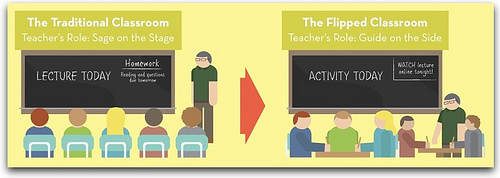I attended a Learning and Skills Group webinar on flipped learning for effective blended learning on 7th November 2013. The presenter, Joanna Kori from Tata Interactive Systems presented on using a flipped learning model to design a blended learning course for an accelerated leadership learning programme.
What is flipped learning?

Flipped Learning by AJC1 on Flickr (CC BY-SA 2.0)
As the image above illustrates flipped learning inverts the traditional teaching model. It moves direct instruction of core knowledge away from the lecture room, with the help of technology, and uses face-to-face teaching time to check understanding, increase interaction and to concentrate on concept engagement (Hamdan et al. 2013). This can create the potential for students to take responsibility for their learning and review core material at a pace that suits them and for teachers to use their face-to-face time to engage students in higher-order thinking (Tokuhama-Espinosa 2013).
Applying a flipped learning model
When thinking about applying a flipped learning approach a model can be a really helpful way to move the focus away from the technology and onto the learning experience that you are trying to promote. Joanna presented on the model she used to design a blended learning course which mapped Bergmann and Sams (2007) flipped model to Kolb’s (1984) experiential cycle and included a range of technologies.
How do I get started with Flipped Learning?
If you are interested in applying a flipped learning model start small and take time to plan your approach to maximise the learning experience. The Turn to your Neighbor blog provides some great resources in the form or a self-paced course to help you plan for a flipped learning curriculum and Faculty Focus have some suggestions to help you find those flippable moments.
There are lots of resources available on how to use technology to present the out-of-class activities, but as Bruff (2012) highlights it is the face-to-face elements that makes a flipped learning model work. Cornell University Centre for Teaching Excellence provides some guidance on how to structure different types of lecture room activities.
References
Bruff, D. (April 20 2012) “Flipping Out” in Agile Learning [blogpost] Available from: http://derekbruff.org/?p=2108 (Accessed: 15.11.13)
Hamdan, N. et al. (2013) A Review of Flipped Learning [online] Available from: http://www.flippedlearning.org/cms/lib07/VA01923112/Centricity/Domain/41/LitReview_FlippedLearning.pdf (Accessed: 15.11.13)
Tokuhama-Espinosa, T. (Apr 2013) The Flipped Classroom: Aiming for Mastery and Differentiation in All Classrooms [Video] Available from: http://www.youtube.com/watch?v=wfANwaX2jdA&feature=player_embedded (Accessed: 15.11.13)




Leave a Reply